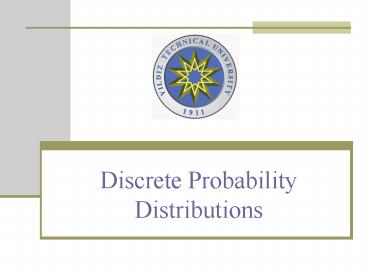Discrete Probability Distributions - PowerPoint PPT Presentation
1 / 67
Title:
Discrete Probability Distributions
Description:
Discrete Random Variable Continuous Random Variable Discrete Random Variables Discrete Probability ... If the probability of success on each trial is p, ... – PowerPoint PPT presentation
Number of Views:264
Avg rating:3.0/5.0
Title: Discrete Probability Distributions
1
Discrete Probability Distributions
2
Random Variable
- Random variable is a variable whose value is
subject to variations due to chance. A random
variable conceptually does not have a single,
fixed value (even if unknown) rather, it can
take on a set of possible different values, each
with an associated probability.
3
Discrete Random Variable
4
Continuous Random Variable
5
Discrete Random Variables
6
Discrete Probability Distribution
7
Discrete Probability Distribution
8
Discrete Random Variable Summary Measures
- Expected Value the expected value of a random
variable is the weighted average of all possible
values that this random variable can take on. The
weights used in computing this average correspond
to the probabilities in case of a discrete random
variable, or densities in case of a continuous
random variable
9
Discrete Random Variable Summary Measures
- Standard deviation shows how much variation or
"dispersion" exists from the average (mean, or
expected value)
10
Discrete Random Variable Summary Measures
11
Probability Distributions
12
The Bernoulli Distribution
- Bernoulli distribution, is a discrete probability
distribution, which takes value 1 with success
probability p and value 0 with failure
probability q1-p . - The Probability Function of this distribution is
The Bernoulli distribution is simply Binomial
(1,p) .
13
Bernoulli Distribution Characteristics
14
The Binomial Distribution
15
Counting Rule for Combinations
16
Binomial Distribution Formula
17
Binomial Distribution
18
Binomial Distribution Characteristics
19
Binomial Characteristics
20
Binomial Distribution Example
21
Geometric Distribution
- The geometric distribution is either of two
discrete probability distributions - The probability distribution of the number of X
Bernoulli trials needed to get one success,
supported on the set 1, 2, 3, ... - The probability distribution of the number
Y X - 1 of failures before the first success,
supported on the set 0, 1, 2, 3, ...
22
Geometric Distribution
- Its the probability that the first occurrence of
success require k number of independent trials,
each with success probability p. If the
probability of success on each trial is p, then
the probability that the kth trial (out of k
trials) is the first success is - The above form of geometric distribution is used
for modeling the number of trials until the first
success. By contrast, the following form of
geometric distribution is used for modeling
number of failures until the first success
23
Geometric Distribution Characteristics
24
The Poisson Distribution
25
Poisson Distribution Formula
26
Poisson Distribution Characteristics
27
Graph of Poisson Probabilities
28
Poisson Distribution Shape
29
The Hypergeometric Distribution
30
Hypergeometric Distribution Formula
31
Hypergeometric Distribution Example
32
Continuous Probability Distributions
33
Continuous Probability Distributions
34
The Normal Distribution
35
Many Normal Distributions
36
The Normal Distribution Shape
37
Finding Normal Probabilities
38
Probability as Area Under the Curve
39
Empirical Rules
40
The Empirical Rule
41
Importance of the Rule
42
The Standart Normal Distribution
43
The Standart Normal
44
Translation to the Standart Normal Distribution
45
Example
46
Comparing x and z units
47
The Standart Normal Table
48
The Standart Normal Table
49
General Procedure for Finding Probabilities
50
z Table Example
51
z Table Example
52
Solution Finding P(0 lt z lt0.12)
53
Finding Normal Probabilities
54
Finding Normal Probabilities
55
Upper Tail Probabilities
56
Upper Tail Probabilities
57
Lower Tail Probabilities
58
Lower Tail Probabilities
59
The Uniform Distribution
60
The Uniform Distribution
61
The Mean and the Standart Deviation for Uniform
Distribution
62
The Uniform Distribution
63
The Uniform Distribution
- Characteristics
64
The Exponential Distribution
65
The Exponential Distribution
66
Shape of the Exponential Distribution
67
Example































